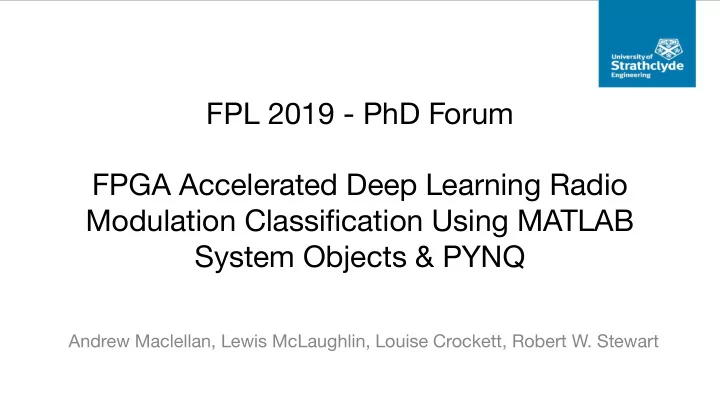

FPL 2019 - PhD Forum FPGA Accelerated Deep Learning Radio Modulation Classification Using MATLAB System Objects & PYNQ Andrew Maclellan, Lewis McLaughlin, Louise Crockett, Robert W. Stewart
Motivation Impact of Deep Learning: Natural Computer Language Vision Processing Object recognition Language translation ● ● Face recognition Speech recognition ● ● Deep Learning Motion estimation Text classification ● ● Image segmentation Language modelling ● ● ... ... ● ●
Motivation Impact of Deep Learning: Natural Computer Language Vision Processing Object recognition Language translation ● ● Face recognition Speech recognition ● ● Deep Learning Motion estimation Text classification ● ● Image segmentation Language modelling ● ● ... ... ● ● Spectrum sensing ● Cognitive radio ● Communications Channel estimation ● Modulation classification ● LTE and 5G NR ● ... ●
Our Aim Develop a workflow for training, quantising, simulating and implementing CNNs for communications on Zynq Figure 1. Credit Mathworks - Zynq SDR Support from Communications Toolbox
Application - Automatic Modulation Classification Application for Spectrum Sensing ● Paper outlining this CNN structure by T. O’shea ● 2016 Apply already proven structure and transfer it to ● hardware. Reduced modulation schemes to 2 for ● implementations simplicity Layer # Layer type Neurons Activations MACs 1 Input 2*128 - - 2 Conv 64*1*3 ReLU 48384 3 Conv 16*2*3 ReLU 761856 IQ Conv Conv Dense Dense Output 4 Dense 128 ReLU 253952 Input ReLU ReLU ReLU 1x2 2 2x128 64x1x3 16x2x3 128 5 Dense 2 Softmax 256 6 Output 2 - -
Quantised CNN Avoid quantising from trained floating-point weights ● GPU Floating-point weights Massive reduction in accuracy ○ Altered our training process to train with quantisation ● limitations Fixed-point weights FPGA (2-bits) Example of kernel quantised training
Quantised CNN
Preliminary Proposed System RFSoC (Zynq UltraScale+ ZCU111 Evaluation Platform) Single chip transmit/receive PYNQ - Python productivity on Zynq - Dynamically change modulation scheme - Visualise the CNN decision making in real-time
Proposed Workflow Integrate with Load weights into Train quantised Generate HDL PYNQ overlay in MATLAB System weights with HDL Coder Vivado Objects ● Configurable System ● Integrate with other ● Train quantised weights ● Generate PYNQ Objects MATLAB HDL IP on DL frameworks bitstream for deployment Adjustable CNN Generate HDL for both Tensorflow/Keras ● ● Interface with Jupyter ● ● dimensions CNN & communications PyTorch notebook ● ● Simulate quantised applications ● MATLAB Deep Learning network using Simulink Toolbox
Thank you! Questions can be answered at the poster. Feel free to come and discuss with us :)
Recommend
More recommend